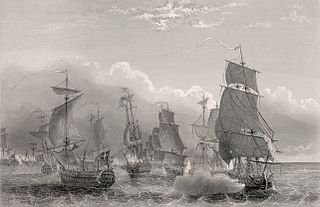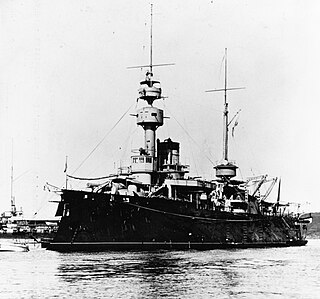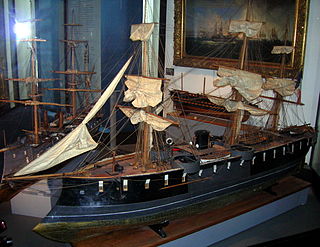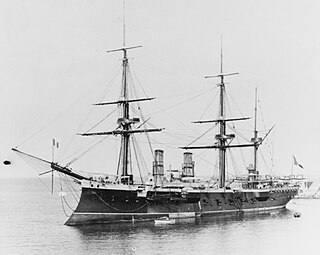
A frigate is a type of warship. In different eras, the roles and capabilities of ships classified as frigates have varied somewhat.

A navy, naval force, military maritime fleet, war navy, or maritime force is the branch of a nation's armed forces principally designated for naval and amphibious warfare; namely, lake-borne, riverine, littoral, or ocean-borne combat operations and related functions. It includes anything conducted by surface ships, amphibious ships, submarines, and seaborne aviation, as well as ancillary support, communications, training, and other fields.

A ship of the line was a type of naval warship constructed during the Age of Sail from the 17th century to the mid-19th century. The ship of the line was designed for the naval tactic known as the line of battle, which involved the two columns of opposing warships maneuvering to volley fire with the cannons along their broadsides. In conflicts where opposing ships were both able to fire from their broadsides, the opponent with more cannons firing – and therefore more firepower – typically had an advantage.

Janes Fighting Ships is an annual reference book of each country's navy, coast guard, and associated aircraft. Included are ship names, construction data, size, speed, range, complement, engineering, armament, and sensors. This can be followed by relevant commentary. Often referred to as the "Bible" of the world's navies. Originally, it was illustrated with ink sketches done by founder, Fred T. Jane (1865-1916). It is his surname "Jane" that makes this title distinctive.

The Naval Annual was a periodical that provided considerable text and graphic information which had previously been obtainable only by consulting a wide range of often foreign language publications. During its life it underwent a number of title changes.

The Royal Louis was a ship of the line of the French Royal Navy. She was constructed at Toulon between 1666 and 1669 under the direction of Rodolphe Gédéon and served as flagship of the French fleet in the Mediterranean.

Courbet was an Dévastation-class ironclad central battery battleship of the French Navy.

The Battle of Martinique, or Combat de la Martinique, was a naval encounter on 18 December 1779 between a British 13-ship squadron under Admiral Hyde Parker and a three-ship French division under Admiral Lamotte-Picquet near the island of Martinique in the West Indies.

Formidable was an ironclad barbette ship built for the French Navy between her keel laying in late 1879 and her completion in early 1889. She was the second and final member of the Amiral Baudin class. The ships of the class was designed in response to Italian naval expansion, and carried a main battery of three 370 mm (14.6 in) guns all mounted in open barbettes on the centerline. The armament was chosen after public pressure to compete with the very large guns mounted on the latest Italian ironclads.

Carnot was a pre-dreadnought battleship of the French Navy. She was laid down in July 1891, launched in July 1894, and completed in July 1897. She was a member of a group of five broadly similar battleships, along with Charles Martel, Jauréguiberry, Bouvet, and Masséna, which were ordered in response to the British Royal Sovereign class. Like her half-sisters, she was armed with a main battery of two 305 mm (12 in) guns and two 274 mm (10.8 in) guns in individual turrets. She had a top speed of 17.8 knots.

Charles Martel was a pre-dreadnought battleship of the French Navy built in the 1890s. Completed in 1897, she was a member of a group of five broadly similar battleships ordered as part of the French response to a major British naval construction program. The five ships were built to the same basic design parameters, though the individual architects were allowed to deviate from each other in other details. Like her half-sisters—Carnot, Jauréguiberry, Bouvet, and Masséna—she was armed with a main battery of two 305 mm (12 in) guns and two 274 mm (10.8 in) guns. The ship had a top speed of 18 knots.

Amiral Baudin was an ironclad barbette ship of the French Navy built in the late 1870s and 1880s. She was the lead ship of the Amiral Baudin class, which included one other vessel, Formidable. The Amiral Baudin class was designed in response to Italian naval expansion, and carried a main battery of three 370 mm (14.6 in) guns all mounted in open barbettes on the centerline. The armament was chosen after public pressure to compete with the very large guns mounted on the latest Italian ironclads. Amiral Baudin was laid down in 1879 and was completed in 1888.

Hoche was an ironclad battleship built as a hybrid barbette–turret ship for the French Navy in the 1880s. Originally designed in response to very large Italian ironclads along the lines of the French Amiral Baudin class, by the time work on Hoche began, changes in French design philosophy led to a radical re-design that provided the basis for a generation of French capital ships. Her armament was reduced in size compared to the Amiral Baudins, and was placed in the lozenge arrangement that would be used for most French capital ships into the 1890s. Hoche suffered from serious stability problems that resulted from her large superstructure and low freeboard, which required extensive work later in her career to correct. The ship incorporated new technologies for the French Navy, including gun turrets for some of her main battery guns and compound armor plate.

Amiral Duperré was an ironclad barbette ship built for the French Navy in the 1870s and 1880s; she was the first vessel of that type built by France. She carried her main battery of four 34 cm (13.4 in) guns individually in open barbette mountings, which offered increased fields of fire compared to earlier central battery ships, though they were less well protected. Amiral Duperré was ordered as part of a French naval construction program aimed at countering the growth of the Italian fleet, which had begun work on the very large ironclads of the Duilio and Italia classes in the early 1870s. The Italian vessels, armed with 45 cm (17.7 in) guns, prompted public outcry in France that pressured the navy to develop larger guns for its own ships. Amiral Duperré's design served as the basis for several follow-on classes, including the Bayard and Amiral Baudin classes.
The Charles Martel class was a planned class of ironclad barbette ships of the French Navy. The class comprised two ships, Charles Martel and Brennus, and represented an incremental improvement over the preceding Marceau class, being larger, but carrying the same main battery of four 340 mm (13.4 in) guns in single mounts. Details of the ships' construction are unclear and contradictory, with various sources reporting that both ships were laid down, or that only Brennus was begun; neither ship was launched before they were cancelled in 1884 or 1886. Some sources indicate that Brennus was redesigned and completed as France's first pre-dreadnought battleship, Brennus, but most other historians dispute the idea.

The Océan-class ironclads were a class of three wooden-hulled armored frigates built for the French Navy in the mid to late 1860s. Océan attempted to blockade Prussian ports in the Baltic Sea in 1870 during the Franco-Prussian War and Marengo participated in the French conquest of Tunisia in 1881. Suffren was often used as the flagship for the Cherbourg Division, the Channel Division, Mediterranean Squadron and the Northern Squadron during her career. The ships were discarded during the 1890s.

The Friant class comprised three protected cruisers of the French Navy built in the early 1890s; the three ships were Friant, Bugeaud, and Chasseloup-Laubat. They were ordered as part of a naval construction program directed at France's rivals, Italy and Germany, particularly after Italy made progress in modernizing its own fleet. The plan was also intended to remedy a deficiency in cruisers that had been revealed during training exercises in the 1880s. As such, the Friant-class cruisers were intended to operate as fleet scouts and in the French colonial empire. The ships were armed with a main battery of six 164 mm (6.5 in) guns supported by four 100 mm (3.9 in) guns and they had a top speed of 18.7 knots.

Sfax was a protected cruiser built for the French Navy in the 1880s. She was the first vessel of the type to be built for the French Navy, which was a development from earlier unprotected cruisers like Milan. Unlike the earlier vessels, Sfax carried an armor deck that covered her propulsion machinery and ammunition magazines. Intended to be used as a commerce raider in the event of war with Great Britain, Sfax was rigged as a barque to supplement her engines on long voyages abroad. She was armed with a main battery of six 164 mm (6.5 in) guns and a variety of lighter weapons.

Forbin was a protected cruiser, the lead ship of the Forbin class, built in the late 1880s for the French Navy. The class was built as part of a construction program intended to provide scouts for the main battle fleet. They were based on the earlier unprotected cruiser Milan, with the addition of an armor deck to improve their usefulness in battle. They had a high top speed for the time, at around 20 knots, and they carried a main battery of four 138 mm (5.4 in) guns.























